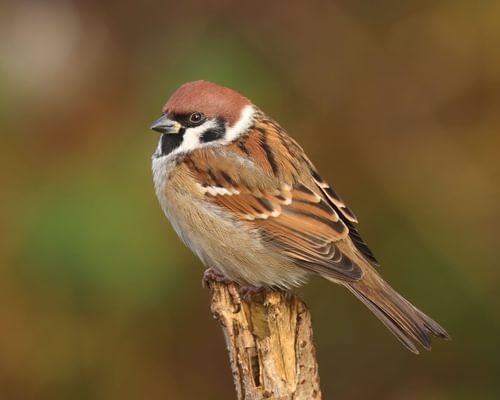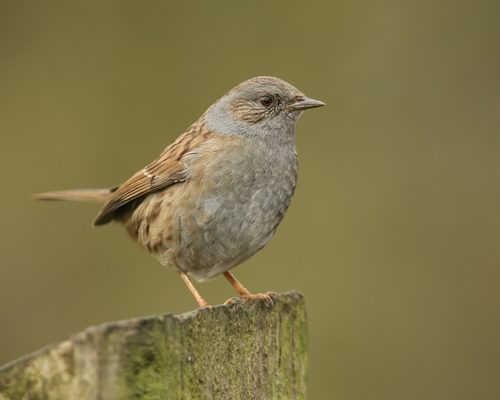House Sparrow
Least ConcernPasser domesticus
Visual Identification
Appearance
House Sparrows are small, plump birds with rounded heads and stout beaks. Males have a grey crown, chestnut-brown nape, and black bib that expands during breeding season. Their wings display distinct brown and black streaks.
Females are duller, with a mix of brown and grey feathers and a pale stripe behind the eye. Juveniles resemble females but have less defined markings and a yellowish gape.
Size
Length
14cm to 18cm
Wingspan
19cm to 25cm
Weight
24g to 39g
Habitat and Distribution
Habitats
Woodland
Garden
Wetland
Coastal
Urban
Farmland
Grassland
Desert
Tundra
Rainforest
Mountain
Savanna
Distribution
House Sparrows are found on every continent except Antarctica, thriving in human-modified environments. They inhabit urban areas, farmlands, and suburban gardens, often nesting in buildings and other structures.
They are widespread across the UK, USA, Canada, and Australia. While generally non-migratory, some northern populations may move short distances during harsh winters.
Elevation Range
Up to 4,500 meters
Climate zones
Temperate, Subtropical, Tropical
Distribution Map
This map gives you a rough idea of where you might spot a House Sparrow. The coloured areas show countries where these birds have been seen.
A few things to keep in mind:
- Birds might not be everywhere in the coloured areas, for example, they may be present around the coast of that country
- Where birds live can change with seasons and available food
- This map is quite simple - it doesn't show exact locations
We're working on making our maps even better! Soon, we hope to show you:
- More detailed maps for bigger countries, including state and region
- How birds move around during different seasons
Distribution by Region
Behaviour and Ecology
Bird Attributes
This feature is in beta. We'd love your feedback to improve it!
Share your thoughtsBird Attributes Explained
Our bird attributes system rates various aspects of a bird's capabilities on a scale of 0-100, based on data from field observations, scientific studies, and expert knowledge.
Attribute Categories:
- Agility: Manoeuvrability, speed, and grace in flight or movement.
- Strength: Physical power, often correlating with size and hunting abilities.
- Adaptability: Ability to thrive in various environments or changing conditions.
- Aggressiveness: Territorial behaviour and assertiveness, particularly during breeding seasons.
- Endurance: Stamina, often seen in migration patterns or foraging behaviours.
Understanding the Ratings:
- 0-20: Very Low
- 21-40: Low
- 41-60: Average
- 61-80: High
- 81-100: Very High
Remember, these attributes are relative to other bird species and don't necessarily indicate superiority.
Hover over the icon next to each attribute for more information.
Tap the icon next to each attribute for more information.
Agility
Reflects the bird's manoeuvrability, speed, and grace in flight or movement.
House Sparrows display considerable agility, particularly in urban environments. Their ability to hop quickly on the ground, navigate through tight spaces in buildings, and manoeuvre swiftly in flight demonstrates good agility for a small bird.
Strength
Indicates the bird's physical power, often correlating with size and hunting abilities.
As small birds, House Sparrows have limited strength. However, they are robust enough to carry nesting materials and defend their territories, which requires a moderate level of strength relative to their size.
Adaptability
Represents the bird's ability to thrive in various environments or changing conditions.
House Sparrows exhibit exceptional adaptability. Their global distribution, ability to thrive in various habitats from urban areas to farmlands, and opportunistic feeding habits showcase their remarkable capacity to adapt to different environments and food sources.
Aggressiveness
Measures the bird's territorial behaviour and assertiveness, particularly during breeding seasons.
While not typically aggressive towards humans, House Sparrows display moderate aggression in flock dynamics and when defending nesting sites. Their 'quarrelsome' nature and ability to outcompete other birds for resources indicate a notable level of assertiveness.
Endurance
Reflects the bird's stamina, often seen in migration patterns or foraging behaviours.
House Sparrows demonstrate good endurance, evidenced by their ability to survive in diverse climates, including harsh winters in some regions. Their capacity to breed multiple times per season and forage actively throughout the day also suggests solid endurance for a small bird.
Diet
House Sparrows are omnivorous, primarily feeding on seeds, grains, and insects. They readily eat human food scraps in urban areas.
During the breeding season, they increase their intake of insects to feed their young. These adaptable birds also consume buds, berries, and small fruits when available.
They can be a pest in farming areas due to their habit of eating grain crops and stored grains and animal feeds.
Behaviour
House Sparrows are highly social, often seen in noisy flocks. They hop rather than walk when on the ground, frequently dust-bathe, and are known for their bold behaviour around humans. These birds are opportunistic feeders, readily visiting bird feeders and scavenging in urban areas.
Vocalisation
House Sparrows are known for their constant chirping. Their most common call is a simple 'cheep' or 'chirp'. Males have a repetitive 'chirrup' song used for courtship and territory defence. In flocks, they produce a variety of chattering sounds, creating a lively, social atmosphere.
These birds are most vocal in the mid-afternoon, although you might hear them at any time of day.
Nesting & Breeding
House Sparrows form monogamous pairs, typically breeding from early spring to late summer. Males attract females by calling and displaying their black bibs.
Nests are built in cavities of buildings, nest boxes, or dense vegetation. They're messy structures made of grass, feathers, and debris. Females lay 3-7 whitish eggs with brown speckles.
Incubation lasts about 11-14 days, shared by both parents. Chicks fledge after 14-16 days but continue to be fed by parents for another 1-2 weeks.
Lifespan
years
The House Sparrow typically lives for 3 to 5 years.
Like all birds, lifespan can be affected by factors including predation, habitat quality, disease, and access to food sources.
Conservation and Status
Global Conservation Status
While globally listed as Least Concern, House Sparrow populations have declined significantly in some urban areas, particularly in the UK and parts of Europe.
Factors include changes in agricultural practices, reduction in nesting sites, and increased predation. Conservation efforts focus on providing suitable nesting habitats in urban environments.
Birdwatching Tips
- Look for flocks in urban and suburban areas, especially near buildings and parks.
- Listen for their distinctive chirping calls, often heard in groups.
- Observe their behaviour around bird feeders, where they're frequent visitors.
- In the UK and US, check eaves and building crevices for nesting sites.
Additional Information
Quick Facts
Other names:
English Sparrow, Domestic Sparrow
Family:
PasseridaePredators
Common predators include domestic cats, hawks, owls, and corvids. In urban areas, they may also fall victim to window collisions and vehicle strikes.
Did You Know?
- House Sparrows can swim to escape predators, though they're not aquatic birds.
- They were intentionally introduced to many parts of the world in the 1800s.
- A group of sparrows is called a 'quarrel' due to their noisy, squabbling nature.
Was this bird profile helpful?
Your feedback helps us improve our content
Thanks for your feedback!
Your input helps us improve our content.
Community Experience
Community Ratings
2 ratings from birders
Latest Community Reviews
Judith Campbell
Skylar Goetz
Community Reviews
Create Your Free Account Welcome Back!
Join our community to rate birds and share your experiences. Creating an account is completely free and only takes a minute. Sign in to your account to rate birds and share your experiences with our community.
Your information is secure and will never be shared.
By creating an account, you agree to our Privacy Policy.
Similar Birds
References
- 1 2
website: BirdLife International. 2019. Passer domesticus (amended version of 2018 assessment). The IUCN Red List of Threatened Species 2019: e.T103818789A155522130.
View source - 3
report, 2015: EBCC

